Countdown to Ecuador
The countdown has begun! In just a few weeks, I'll be heading off on an 8-day bird photography journey through the lush and diverse landscapes of Ecuador, guided by the renowned Magic Birding Circuit. This trip has been months in the making, from meticulously planning the itinerary to booking the flights, and now, as the departure date draws near, I’m excited to share what I’ve packed to ensure I capture the best possible images of Ecuador's vibrant birdlife.
Why Ecuador?
Ecuador is a paradise for bird photographers, boasting an incredible array of species within its compact borders. From the colorful tanagers to the elusive antpittas, the variety of birds here is astonishing. With the Magic Birding Circuit's expert guidance, I’m looking forward to exploring some of the most biodiverse spots in the country, from cloud forests to lowland rainforests, each offering unique photographic opportunities.
Gearing Up for the Adventure
Photographing birds in Ecuador's diverse environments requires careful preparation. Here’s a list of the essential gear I’m bringing along
Cameras
Canon EOS R5: A full-frame, 45mp powerhouse, perfect for high-resolution wildlife shots with advanced autofocus capabilities.
Canon EOS R7: My go-to workhorse, a 32mp crop sensor mirrorless camera, ideal for getting that extra reach needed in wildlife photography.
Canon EOS 5DSr:A full-frame DSLR with a remarkable 50.6mp resolution, perfect for capturing stunning landscape detail.
DJI Osmo Action 3: A compact, rugged action camera designed for capturing high-quality video and photos in extreme conditions. It features 4K video recording, excellent stabilization, and a waterproof build, making it ideal for adventure photography.
Lenses:
Canon EF 600mm f/4L IS USM: My primary wildlife lens, offering exceptional reach and clarity, allowing me to photograph from a distance while maintaining image quality.
Canon EF 300mm f/2.8L IS USM: A versatile lens for wildlife, especially in low light, offering an effective field of view of 480mm on the R7 and up to 672mm with a 1.4x teleconverter.
Canon EF 24-70mm f/2.8L II USM: A versatile zoom lens for landscape photography, offering a wide range of focal lengths.
Canon EF 100mm f/2.8L Macro IS USM: Excellent macro photography lens.
Tripods and Heads:
Leofoto PG-1 Gimbal Head: Allows smooth movement and precise adjustments for capturing wildlife at eye level.
Leofoto Ranger Series LS324C PRO Tripod: A sturdy carbon fiber tripod, essential for sharp, high-quality landscape images.
ProMaster SPH45P Ball Head: Offers smooth, precise movement and a secure camera mount.
3 Legged Thing Punks Trent 2.0 Monopod: Provides additional support and quick setup, ideal for on-the-go photography.
-Wimberley MH-100 MonoGimbal Head: Enables fluid motion and stable support, perfect for wildlife photography.
Other Accessories:
PortKeys PT6 External Camera Monitor: Enhances low-angle photography with a larger, clearer display for precise framing and focusing.
LensCoat® RainCoat Pro: Protects my camera and lens from inclement weather.
LensCoat® Travel Hood: Provides robust protection for my 600mm lens during travel.
PolarPro Summit Landscape Filter System:Enables creative control over landscape photography with various filters.
Peak Design “Slide” Camera Strap System: Offers comfortable and versatile carrying options for my camera.
Pluto Trigger: Offers advanced remote triggering capabilities, expanding creative possibilities.
Hoodman HoodLoupe Outdoor LCD Loupe: Ensures accurate composition and focus checking.
Canon 580EX II Flash: Provides additional lighting options for wildlife photography.
Wimberly F-1 Telephoto Flash Bracket: Enables off-camera flash positioning for telephoto lenses.
Better Beamer Flash Extender: Extends the reach and efficiency of my flash unit.
Flashpoint Blast Power Pack BP960: Enhances the performance of my external flash unit, providing reliable power for extended shoots.
Zemlin Photo Lens Caps: Provides superior front-element protection for my large lenses.
Brevite Jumper Camera Bag: This bag will allow me to carry my extra camera body, smaller lenses, batteries and hard drives on the plan
Pelican 1510 Travel Case: Offers ultimate protection for my gear during travel, carry-on size for air travel.
Pelican 1595 Travel Case: Offers ultimate protection for my tripods and other accessories as checked luggage
Extra Canon Batteries.
Samsung SSD Drives: 2 1TB Drives and a 2TB Drive.
Pro Media SD Cards.
Apple AirTags.
Packing the Gear
Given the carry-on and weight restrictions for air travel, I was focused on ensuring my most valuable gear would stay with me on the plane. I decided to pack my 600mm and 300mm lenses, along with my R7 camera body, into my Pelican 1510 case. The rest of my lenses, my R7, DJI Action 3, batteries, and hard drives will be packed into my Brevite Jumper camera bag, which fits neatly under the seat in front of me. My remaining gear, including tripods, accessories, and my Canon 5DSr, will go into my Pelican 1595 case as checked luggage.
The Journey Ahead
As I embark on this adventure, I’ll be sharing updates and images on my social media channels, so stay tuned for a behind-the-scenes look at how I pack all of this gear along with the beauty of Ecuador and its avian inhabitants. I’ll also be documenting the trip for future blog posts, where I’ll dive into the details of each location we visit and the birds we encounter.
This trip promises to be a remarkable experience, and I’m eager to see what surprises Ecuador has in store. Whether it’s capturing the vibrant plumage of a toucan or the delicate movements of a hummingbird, I’m ready to immerse myself in the magic of bird photography in one of the world’s most biodiverse countries.



